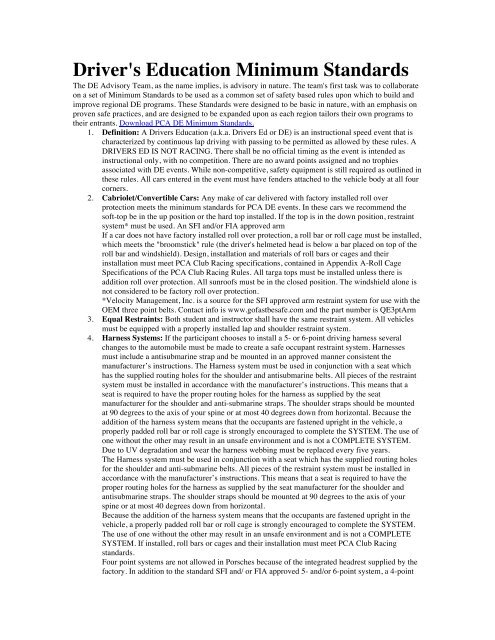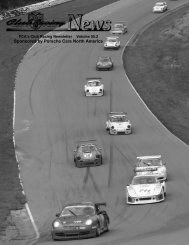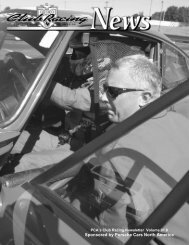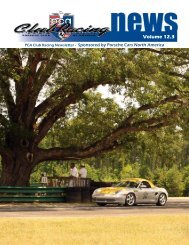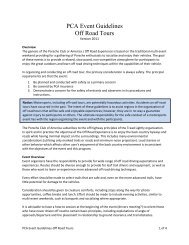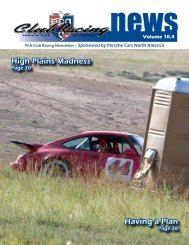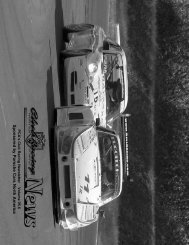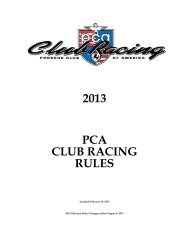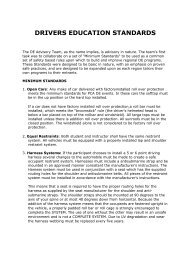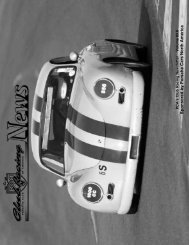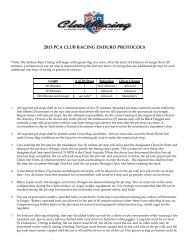Driver's Education Minimum Standards - Porsche Club of America
Driver's Education Minimum Standards - Porsche Club of America
Driver's Education Minimum Standards - Porsche Club of America
You also want an ePaper? Increase the reach of your titles
YUMPU automatically turns print PDFs into web optimized ePapers that Google loves.
<strong>Driver's</strong> <strong>Education</strong> <strong>Minimum</strong> <strong>Standards</strong><br />
The DE Advisory Team, as the name implies, is advisory in nature. The team's first task was to collaborate<br />
on a set <strong>of</strong> <strong>Minimum</strong> <strong>Standards</strong> to be used as a common set <strong>of</strong> safety based rules upon which to build and<br />
improve regional DE programs. These <strong>Standards</strong> were designed to be basic in nature, with an emphasis on<br />
proven safe practices, and are designed to be expanded upon as each region tailors their own programs to<br />
their entrants. Download PCA DE <strong>Minimum</strong> <strong>Standards</strong>.<br />
1. Definition: A Drivers <strong>Education</strong> (a.k.a. Drivers Ed or DE) is an instructional speed event that is<br />
characterized by continuous lap driving with passing to be permitted as allowed by these rules. A<br />
DRIVERS ED IS NOT RACING. There shall be no <strong>of</strong>ficial timing as the event is intended as<br />
instructional only, with no competition. There are no award points assigned and no trophies<br />
associated with DE events. While non-competitive, safety equipment is still required as outlined in<br />
these rules. All cars entered in the event must have fenders attached to the vehicle body at all four<br />
corners.<br />
2. Cabriolet/Convertible Cars: Any make <strong>of</strong> car delivered with factory installed roll over<br />
protection meets the minimum standards for PCA DE events. In these cars we recommend the<br />
s<strong>of</strong>t-top be in the up position or the hard top installed. If the top is in the down position, restraint<br />
system* must be used. An SFI and/or FIA approved arm<br />
If a car does not have factory installed roll over protection, a roll bar or roll cage must be installed,<br />
which meets the "broomstick" rule (the driver's helmeted head is below a bar placed on top <strong>of</strong> the<br />
roll bar and windshield). Design, installation and materials <strong>of</strong> roll bars or cages and their<br />
installation must meet PCA <strong>Club</strong> Racing specifications, contained in Appendix A-Roll Cage<br />
Specifications <strong>of</strong> the PCA <strong>Club</strong> Racing Rules. All targa tops must be installed unless there is<br />
addition roll over protection. All sunro<strong>of</strong>s must be in the closed position. The windshield alone is<br />
not considered to be factory roll over protection.<br />
*Velocity Management, Inc. is a source for the SFI approved arm restraint system for use with the<br />
OEM three point belts. Contact info is www.g<strong>of</strong>astbesafe.com and the part number is QE3ptArm<br />
3. Equal Restraints: Both student and instructor shall have the same restraint system. All vehicles<br />
must be equipped with a properly installed lap and shoulder restraint system.<br />
4. Harness Systems: If the participant chooses to install a 5- or 6-point driving harness several<br />
changes to the automobile must be made to create a safe occupant restraint system. Harnesses<br />
must include a antisubmarine strap and be mounted in an approved manner consistent the<br />
manufacturer’s instructions. The Harness system must be used in conjunction with a seat which<br />
has the supplied routing holes for the shoulder and antisubmarine belts. All pieces <strong>of</strong> the restraint<br />
system must be installed in accordance with the manufacturer’s instructions. This means that a<br />
seat is required to have the proper routing holes for the harness as supplied by the seat<br />
manufacturer for the shoulder and anti-submarine straps. The shoulder straps should be mounted<br />
at 90 degrees to the axis <strong>of</strong> your spine or at most 40 degrees down from horizontal. Because the<br />
addition <strong>of</strong> the harness system means that the occupants are fastened upright in the vehicle, a<br />
properly padded roll bar or roll cage is strongly encouraged to complete the SYSTEM. The use <strong>of</strong><br />
one without the other may result in an unsafe environment and is not a COMPLETE SYSTEM.<br />
Due to UV degradation and wear the harness webbing must be replaced every five years.<br />
The Harness system must be used in conjunction with a seat which has the supplied routing holes<br />
for the shoulder and anti-submarine belts. All pieces <strong>of</strong> the restraint system must be installed in<br />
accordance with the manufacturer’s instructions. This means that a seat is required to have the<br />
proper routing holes for the harness as supplied by the seat manufacturer for the shoulder and<br />
antisubmarine straps. The shoulder straps should be mounted at 90 degrees to the axis <strong>of</strong> your<br />
spine or at most 40 degrees down from horizontal.<br />
Because the addition <strong>of</strong> the harness system means that the occupants are fastened upright in the<br />
vehicle, a properly padded roll bar or roll cage is strongly encouraged to complete the SYSTEM.<br />
The use <strong>of</strong> one without the other may result in an unsafe environment and is not a COMPLETE<br />
SYSTEM. If installed, roll bars or cages and their installation must meet PCA <strong>Club</strong> Racing<br />
standards.<br />
Four point systems are not allowed in <strong>Porsche</strong>s because <strong>of</strong> the integrated headrest supplied by the<br />
factory. In addition to the standard SFI and/ or FIA approved 5- and/or 6-point system, a 4-point
system is allowed in non-<strong>Porsche</strong>s that meet the following requirements:<br />
- Meets the Federal Motor Vehicle Safety Standard 209.<br />
- Attaches to the factory seat belt mounting points.<br />
- Each belt is designed to work in a specific vehicle and that vehicle tag must be attached to the<br />
belt system.<br />
An example <strong>of</strong> a system that meets the above criteria is the Schroth Quick Fit system.<br />
5. Medical Personnel at the site: The minimum standards are one EMT trained attendant and an<br />
emergency equipped vehicle.<br />
6. Fire and Emergency at the site: There must be personnel trained in fire and emergency<br />
situations and the site must have either a fire truck and /or a tow truck equipped with fire<br />
emergency equipment.<br />
7. Insurance: All events must meet the PCA insurance carrier's requirements and everyone entering<br />
the event location must sign the insurance waiver.<br />
8. <strong>Driver's</strong> License: All entrants must have a valid driver's license (state, country or province as<br />
appropriate).<br />
9. Car Occupancy:If two people are in a car, one must be an approved event instructor and the other<br />
must be a registered entrant in the event. There are no exceptions to this rule. Registering people<br />
for the sole purpose <strong>of</strong> “thrill” rides is not acceptable. A registered entrant is defined as a person<br />
who will be participating in substantially all appropriate aspects <strong>of</strong> the event (on track, classroom<br />
and exercises, any corner working). This does not mean, however, that a registered entrant must<br />
attend the event full time, or participate in classroom sessions or exercises that are not scheduled<br />
for such entrant (e.g., instructors and advanced students need not participate in classroom session<br />
or exercises developed for novice drivers; corner working is not necessary if there are pr<strong>of</strong>essional<br />
corner workers).<br />
10. Corner Workers: A minimum <strong>of</strong> one person per designated station and the station must be<br />
equipped with an appropriate complement <strong>of</strong> flags, fire extinguisher, and communication<br />
equipment (radio or track hardwire system).<br />
11. Run Groups: The grouping <strong>of</strong> drivers into run groups shall be assigned in terms <strong>of</strong> their track<br />
driving experience and capability, as well as speed potential <strong>of</strong> the cars. All novice drivers shall be<br />
assigned an event-approved instructor to ride with them for in-car instruction.<br />
12. Clothing: All car occupants must wear a Snell approved helmet, which has the current available<br />
Snell rating or the one previous Snell rating. Other helmets are acceptable if they are approved for<br />
PCA <strong>Club</strong> Racing. Footwear must be enclosed, non-slip, with a relatively smooth sole. Hiking<br />
type deep lugged soles are not acceptable.<br />
13. Eye Protection: If the car does not have a windshield, the driver must be equipped with eye<br />
protection.<br />
14. Drivers' Meeting: All events must have a drivers' meeting prior to putting cars on the track to<br />
review event procedures and policies.<br />
15. Car Safety Inspection: The car owner must certify that the car is safe to run on the track and that<br />
the car has been inspected by an regionally approved person or shop within thirty days prior to the<br />
event.<br />
16. Final Safety Inspection: A final safety inspection <strong>of</strong> the car shall be performed within 24 hours at<br />
a site near or at the event facility.This should include inspection <strong>of</strong> the helmet, the restraint<br />
system, all loose objects to be removed, gas cap must be tight and any other items deemed<br />
necessary by the event chairman. The car is identified with a sticker or some other means as<br />
having passed the final inspection.<br />
17. Passing Zones: Passing zones for all groups shall be well defined at the Drivers Meeting. All<br />
passing must be completed by the end <strong>of</strong> the passing zone as defined by the event organizer. Road<br />
courses associated with super speedways may use the super speedway turns as passing zones<br />
(turns on the portion <strong>of</strong> the track comprised <strong>of</strong> the oval section <strong>of</strong> the super speedway); e.g., Turn<br />
3 at Pocono, or NASCAR Turns 1, 2, 3 and 4 at Texas Motor Speedway. There shall be no<br />
passing in any other turns except as allowed by the Expanded Passing Program. Kinks in a<br />
straight area <strong>of</strong> the track will not be considered turns unless specified by the Event Chairman. The<br />
Event Chairman shall take into consideration the areas <strong>of</strong> the track that are preferred for passing,<br />
and may restrict certain passing zones to advanced run groups. THERE WILL BE NO PASSING<br />
UNDER RED FLAG CONDITIONS. THERE IS ALSO NO PASSING UNDER YELLOW
FLAG CONDITIONS EXCEPT FOR SLOW MOVING VEHICLES WHOSE DRIVERS HAVE<br />
SIGNALLED THAT THEIR VEHICLES ARE DISABLED.<br />
18. Passing Signals and Procedures: All passing in the designated areas will be with the use <strong>of</strong> hand<br />
signals to direct the passing car safely around the car being passed. It is preferred that the car<br />
being passed remains on line allowing the faster car to pass safely. In the event <strong>of</strong> drivers who,<br />
due to a physical impairment, are unable to use hand signals, the use <strong>of</strong> turn signals to signal<br />
passing will be permitted. It is recommended that such drivers and their cars, if any, be identified<br />
in the Drivers' Meeting.<br />
19. Expanded Passing Program: The Event Chairman may choose to implement the expanded<br />
passing program. With expanded passing, passing may occur on all portions <strong>of</strong> the track, including<br />
all turns. If expanded passing is allowed at an event, it shall follow these restrictions:<br />
• Expanded passing will ONLY be run in the Instructors run group which may include noninstructors.<br />
• All passing must be initiated WITH A HAND SIGNAL.<br />
• All signals MUST BE demonstratively clear and there must be one for each car.<br />
• All signals are “real time”. If you initiate a pass with a signal, expect a car to pass at the time you<br />
give the signal, not at the next straight away.<br />
• All signals are a contract between two drivers. If you initiate, let the car pass. If you are given a<br />
signal and decline, you must wave <strong>of</strong>f the signal.<br />
• No more than two cars side by side in the turn.<br />
• When entering a turn with another car, NO ONE OWNS THE TURN. Each driver is entitled to<br />
50% <strong>of</strong> the track as if there was a white line through the center <strong>of</strong> the turn.<br />
• The only passengers allowed in the expanded passing run groups are qualified instructors.<br />
• All drivers <strong>of</strong> the designated run group must participate in expanded passing. Any driver who<br />
does not care to participate must be moved to another run group.<br />
• When entering a turn with another car, NO ONE OWNS THE TURN. Each driver is entitled to<br />
50% <strong>of</strong> the track as if there was a white line down the middle.<br />
• The Chief Driving Instructor may designate up to five (5) instructors per event who may take<br />
advanced students as passengers (no beginners or novices), for the purpose <strong>of</strong> instruction only.<br />
Otherwise, the only passengers allowed in the expanded passing run groups are qualified<br />
instructors.<br />
All drivers <strong>of</strong> the designated run group must willingly participate in expanded passing. Any driver<br />
who does not care to participate must be moved to another run group. This program is self-policed<br />
and any passing done without a signal or over aggressive driving may result in exclusion from the<br />
program or may be dealt with as decided by Regional DE management.<br />
20. Event Control Center: The event control center must have the ability at all times when cars are<br />
on the track, to be in communication with the corner stations and track fire and emergency center.<br />
21. Grid/Pit Marshall: The event organizers must designate a grid and/or pit-out Marshall to control<br />
the flow <strong>of</strong> cars on and <strong>of</strong>f the track.<br />
22. Chief <strong>of</strong> Course: The flag station or person that communicates with event control and all corners.<br />
The chief <strong>of</strong> course is responsible for all reports and actions <strong>of</strong> each <strong>of</strong> the corner stations. The<br />
person coordinates all <strong>of</strong> the actions <strong>of</strong> the corner stations. It can be the same person as in Event<br />
Control but tracks that use pr<strong>of</strong>essional corner workers will usually designate one person on their<br />
team for this role.<br />
23. PCA Observers' Report: The PCA Observers' Report form must be completed by an impartial<br />
party (i.e., not the Event Chairperson or the Chief Instructor) who attended the event.<br />
24. Post Event Report: The PCA Post Event Report form must be completed by the Event<br />
Chairperson.<br />
25. Chief Instructor: The event chairman must designate an individual as Chief Instructor who may<br />
also be the Attitude Adjustment Counselor.<br />
26. Safety Inspector: The event organizers shall designate a person responsible for car inspection at<br />
the event.<br />
27. Novice Meeting: There shall be a mandatory session for all novice drivers, which could include<br />
track etiquette and flagging responsibilities.
28. Erratic Driving: Four wheels <strong>of</strong>f, spin, and/or contact, the driver must come into the pits to have<br />
the car looked over and to be queried for the cause.<br />
29. Entrant Age: The minimum age for any driving entrant is eighteen years.<br />
30. Identification: All cars must be identified with a legible number. Either the car or the driver must<br />
be identified by run group. The use <strong>of</strong> colored wrist bands to identify the entrant and his or her run<br />
group is highly recommended.<br />
31. Lap Timing: PCA DE Programs are not timed events. Any timing is done for instructional<br />
purposes only, and is not part <strong>of</strong> the operation <strong>of</strong> the event.<br />
32. NO ALCOHOL OR CONTROLLED SUBSTANCES CAN BE CONSUMED BY ANY<br />
PARTICIPANT DURING THE HOURS OF EVENT OPERATION, OR BY ANY PERSON<br />
AT THE SITE OF THE EVENT DURING THE HOURS OF EVENT OPERATION. This is<br />
not intended to prevent participants from taking medication as long as it does NOT have an effect<br />
upon the person's ability to control a vehicle at speed.<br />
33. Event Registration: Every entrant must complete a registration form which must include<br />
emergency contact information.<br />
34. Instructor Qualification: Every Region and Zone who organizes a DE event must have an<br />
instructor qualification program.<br />
35. Track Contractual Requirements: The event organizers must adhere to any facility safety<br />
requirement that is more stringent than the PCA minimum standards; e.g., track density, open car<br />
standard, etc.<br />
36. Accident Policy: In the event <strong>of</strong> any car-to-car contact or other contact resulting in physical<br />
damage to an automobile that cannot be buffed out, an incident report must be submitted to the<br />
individuals indicated on the current Incident Report Form within five (5) business days. (Damage<br />
caused by debris or to the wheels/suspension/under-carriage from an <strong>of</strong>f-track excursion does not<br />
require a report.) The report form is available on the web site and is now part <strong>of</strong> the insurance<br />
packet received from the National Office when you submitted an insurance enrollment form. In<br />
case <strong>of</strong> bodily injury to any individual at the event, a report must be written and submitted to our<br />
National Insurance Chairman on the next business day.<br />
37. Time Trials:Regions may optionally <strong>of</strong>fer a Time Trial at a DE event. A Time Trial brings a<br />
competitive aspect to the DE. After all <strong>of</strong> the untimed sessions <strong>of</strong> a DE are finished, there is a final<br />
session that is timed for the purpose <strong>of</strong> <strong>of</strong>ficial scoring. During the Time Trial portion <strong>of</strong> the event,<br />
cars are sent out one at a time on to the track to have their designated number <strong>of</strong> timed laps. All<br />
the allowed timed laps are run continuously, as in practice; however there shall be no passing.<br />
Cars must be released with enough spacing to avoid bunching up, so proper spacing <strong>of</strong> the cars is<br />
really crucial. Typically, this means that only two or three cars can be on the track at a time during<br />
timed runs. The Event Gridmaster should grid cars by speed potential and driver ability, sending<br />
the fastest cars first, and should use his best judgment and discretion as to the spacing.<br />
The Event Chair should have an additional drivers meeting before timed runs start. This drivers<br />
meeting should review (at least): No passing; flag rules; maintaining distance between cars;<br />
number <strong>of</strong> laps to be driven; any safety concerns.<br />
The purpose <strong>of</strong> Time Trialing is to give the entrants a clear track with no distractions, to get an<br />
impartial lap time, and potentially have rankings among the drivers. As always safety is the<br />
primary concern during PCA track events. All standards that apply to a Drivers <strong>Education</strong> will<br />
apply to the Time Trial portion <strong>of</strong> the event except as noted in this section. NOTE THAT THE<br />
PCA LIABILITY INSURANCE SPECIFICALLY PROHIBITS WHEEL-TO-WHEEL<br />
COMPETITION IN THIS CONTEXT.<br />
38. Demonstration Rides:Our Driver’s <strong>Education</strong> (DE) program is based on the core assumption that<br />
these events are instructional in character. Our DE Instructors ride with students in their cars in an<br />
educational capacity. An Instructor is defined as a fully registered entrant who has signed all<br />
waivers and has successfully completed an approved PCA regional or national program. A Student<br />
is defined as a fully registered entrant who has signed all waivers, paid the regionally stated<br />
registration fee, and is driving a car that has met all required safety standards. There are no<br />
exceptions.
38.1: Demonstration Rides for DE Students<br />
There may be times when a “demonstration ride” by an instructor is helpful to further enhance the<br />
educational process. A Demonstration Ride is defined as a student riding with an instructor in one<br />
run group higher than the student’s assigned group. For example, if a novice student would benefit<br />
from a demonstration ride, the ride would occur in an instructed beginner run group, not an<br />
advanced group. If the instructor has more than one student, the demonstration ride can occur in<br />
the lowest experience run group possible. The purpose <strong>of</strong> this ride is to demonstrate the proper<br />
driving techniques to help the student correct his/her issues, not to show how well the instructor<br />
can drive the facility. All DE event rules apply.<br />
In our DE program, there are other forms <strong>of</strong> Demonstration Rides for Non-Students and they are<br />
as follows:<br />
38.2 Taste <strong>of</strong> the Track (DE Track Sampler)<br />
The sole purpose <strong>of</strong> the “Taste <strong>of</strong> the Track” program is to introduce a driving enthusiast to the<br />
wonderful world <strong>of</strong> high performance driving PCA style. We understand that some drivers would<br />
like to learn more about the PCA Driver’s <strong>Education</strong> program, but are not quite ready to be a fulltime<br />
DE Student. With that in mind, this program has the following requirements:<br />
Requirements for the Participant:<br />
• Must be at least eighteen years <strong>of</strong> age.<br />
• Must complete the appropriate entry form, pay the region’s fee, and print & sign all appropriate<br />
insurance waivers.<br />
• Must attend the Region’s novice student activities, including the general driver’s meeting and<br />
Novice classroom session(s).<br />
• Must comply with the PCA Region’s clothing requirements for this event.<br />
• Helmets are not required.<br />
Requirements for the Region:<br />
• Designate a specific “Taste <strong>of</strong> the Track” run group session in the daily schedule. This run group<br />
is for the Taste <strong>of</strong> the Track participants only.<br />
• Assign an approved DE Instructor to each Taste <strong>of</strong> the Track participant.<br />
• The DE Instructor will drive his/her own vehicle in the designated run group. Instructors may<br />
choose to explain the basics <strong>of</strong> driving (e.g., car control, the line, dealing with traffic) and explain<br />
event & track rules (e.g., run group format, corner worker stations).<br />
• Only the approved DE Instructor and her/his student are allowed in the car.<br />
• All vehicle doors must be securely closed and seatbelts securely fastened.<br />
• Helmets are not required.<br />
• It is mandatory to keep speeds well below “track speed,” with a maximum speed <strong>of</strong> 60 mph.<br />
• No passing is allowed.<br />
Note 1: If any <strong>of</strong> the above requirements are not met, PCA may choose to not insure the activity.<br />
Note 2: Track Tours or Taste <strong>of</strong> the Track Programs would be subject to the rules and contractual<br />
terms <strong>of</strong> the individual facilities.<br />
38.3 Track Tours (Parade Laps)<br />
Regions may optionally implement a Track Tour program. This program allows Non-Students the<br />
opportunity to experience the track in a comfortable low-speed session. Passengers are allowed.<br />
Requirements for the Participant(s):<br />
• The participant will be driving his/her own vehicle.<br />
• The driver participant must have a valid driver’s license, pay the region’s entrance fee, and must<br />
print & sign the appropriate insurance waivers.<br />
• All vehicle occupants must sign the appropriate insurance waiver. Under age participants<br />
(minors) must have a responsible adult print & sign the appropriate waiver for them, and shall use<br />
DOT approved restraints appropriate for their age & weight. All occupants will use at least DOT<br />
seatbelts.<br />
• Helmets are not required.<br />
• All vehicle doors must be securely closed and seatbelts securely fastened.
• It is mandatory to keep speeds well below “track speed,” with a maximum speed <strong>of</strong> 60 mph.<br />
• No passing is allowed.<br />
Requirements for the Region:<br />
• The Track Tour program will be run separately from other run groups and may be run without<br />
corner workers.<br />
• No passing is allowed during this session.<br />
• There will be enough pace cars well-spaced in the group to keep speeds below “track speed,”<br />
with a maximum speed <strong>of</strong> 60 mph. Pace car drivers must be at least 18 years <strong>of</strong> age and be<br />
appointed by the Region’s DE event management team.<br />
• Participating vehicles are not limited to <strong>Porsche</strong>s. All participating vehicles must be either<br />
approved by the Chief Tech Inspector as generally roadworthy or have a valid state registration.<br />
Motorcycles and <strong>of</strong>f-road vehicles are not allowed.<br />
Note 1: If any <strong>of</strong> the above requirements are not met, PCA may choose to not insure the activity.<br />
Note 2: Track Tours or Taste <strong>of</strong> the Track Programs would be subject to the rules and contractual<br />
terms <strong>of</strong> the individual facilities.<br />
38.4 Demonstration Rides for Non-Students (Hot Laps, Thrill Rides)<br />
Approximately half <strong>of</strong> the PCA Regions host DE events. In an effort to provide prospective<br />
students/sponsors/friends/family a “taste” <strong>of</strong> the DE experience, regions may have <strong>of</strong>fered rides<br />
with an experienced DE Instructor during a run group session. While we understand the<br />
importance <strong>of</strong> these efforts, some significant risk management concerns have been presented to the<br />
Executive Council. After much discussion, consultation, and careful consideration, the EC has<br />
determined that it is necessary to prohibit Hot Lap rides.<br />
However, we do understand the value <strong>of</strong> <strong>of</strong>fering tours <strong>of</strong> the track to various persons. In order to<br />
support the regions hosting DE events, regions can use the Track Tour model per the<br />
specifications noted in 38.3. In addition, if appropriate, a region may allow Non-Students to attend<br />
a Green Student classroom session, enjoy lunch with region members, or observe from a corner<br />
worker station and/or from the control tower.<br />
The purpose <strong>of</strong> the "<strong>Minimum</strong> <strong>Standards</strong>" is to provide a Region with a base point on which to build their<br />
own regional program. The standards were designed to be minimal in nature so that any region can have<br />
more stringent rules, but none should have any more lenient. Any Region that plans to run a DE event must<br />
strive to meet all the minimum standards. A Region's repeated failure to comply after warnings <strong>of</strong><br />
noncompliance or a Region's refusal to adhere to these standards could prevent the Region from obtaining<br />
PCA insurance for future events. Substantial compliance with these standards would be part <strong>of</strong> the<br />
Observer's Report process. One <strong>of</strong> the functions <strong>of</strong> the advisory committee is to review and modify these<br />
standards, if required. Any modifications to these standards will need Executive Council approval.


